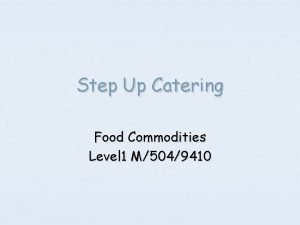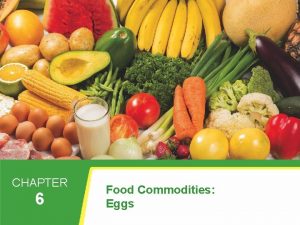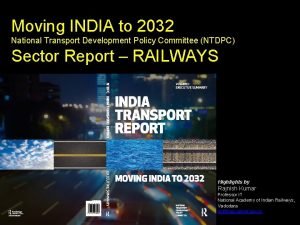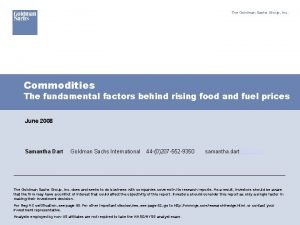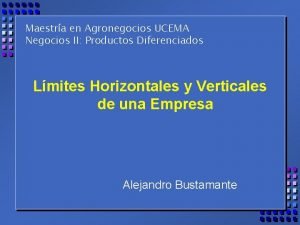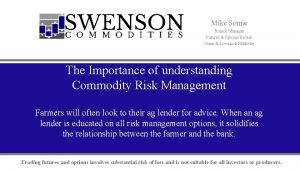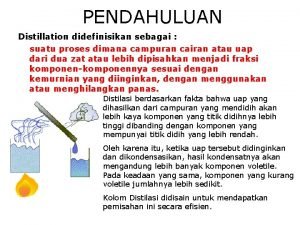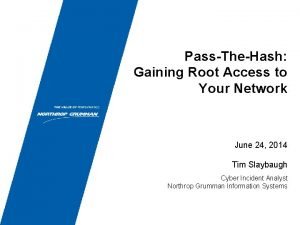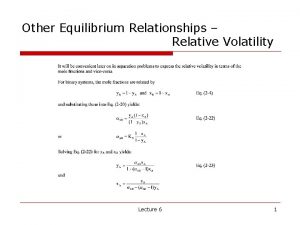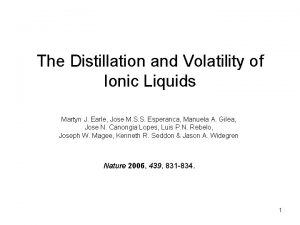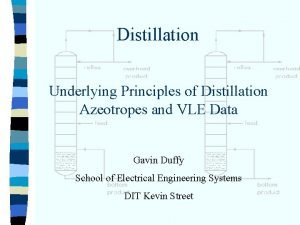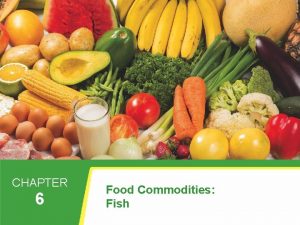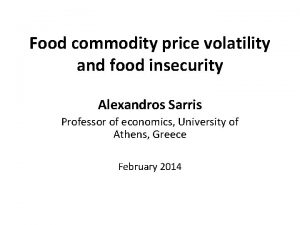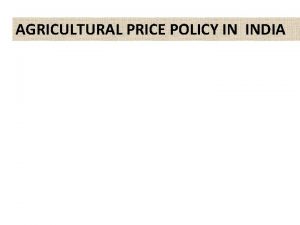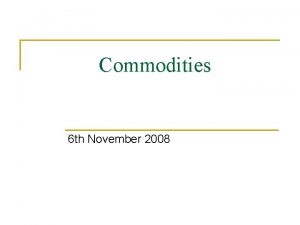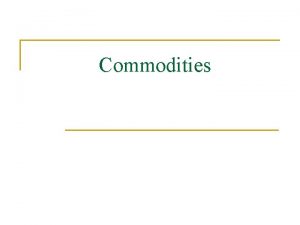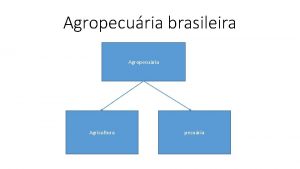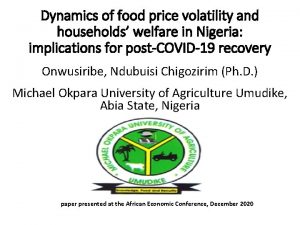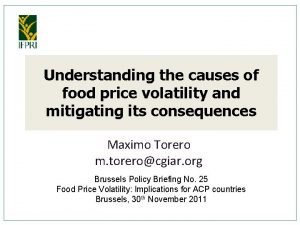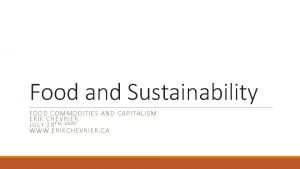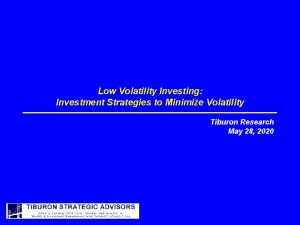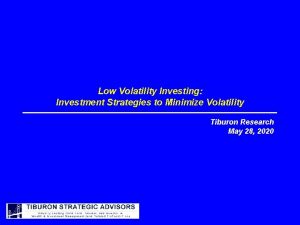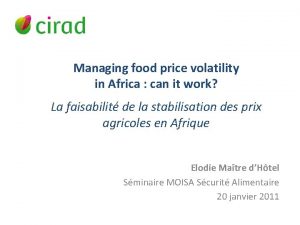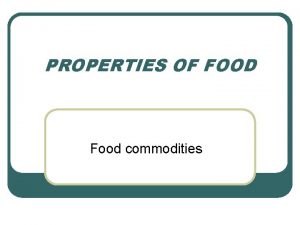Session IV Agricultural commodities price volatility and food


























- Slides: 26

Session IV: Agricultural commodities price volatility and food security Long-Term Lessons from Short-term Volatility Amar Bhattacharya G 24 Secretariat G-20 Conference on Commodity Price Volatility, Istanbul, 12 -13 September 2011

Outline 1. Differential Impacts of agricultural price developments 2. Addressing and coping with short-term volatility 3. Long-term imperative to revitalize agriculture

1. Differential Impacts of Agricultural Price Developments

Long Term Nominal and Real Agricultural Prices Source: World Bank, PINK data.

Variation in Nominal Commodity Prices Across Product Groups Nominal commodity prices Base 100=2000 Energy Agriculturals Beverages Food Raw Materials Metals & Minerals Average values 1960 -1969 1970 -1979 1980 -1989 1990 -1999 2000 -2009 2010 5. 00 34. 28 90. 35 66. 75 172. 65 271. 17 50. 50 101. 15 124. 93 126. 38 144. 29 231. 33 55. 98 151. 69 183. 88 136. 52 143. 28 253. 76 52. 55 106. 00 124. 54 126. 57 148. 77 224. 11 42. 74 63. 68 95. 89 120. 75 133. 90 237. 48 42. 30 68. 55 98. 87 106. 92 186. 67 337. 19 Historical peak 341. 97 2008 231. 33 2010 322. 28 1977 247. 41 2008 237. 48 2010 339. 13 2007 4. 56 1969 48. 12 1962 50. 16 1965 47. 23 1960 37. 65 1971 33. 35 1962 Historical minimum Source: World Bank, PINK data.

Why Differential Impact? • Differences in endowments and production patterns • Differences in consumption patterns • Impact of domestic policies

Net-Exporters and Net-Importers Across Selected Product Categories Product Category Number of Net-Exporters Number of Net-Importers High-income countries Middle-income countries Low-income countries 16 39 15 32 56 24 All food items High-income countries Middle-income countries Low-income countries 14 38 10 34 59 30 Basic food (excl. beverages) High-income countries Middle-income countries Low-income countries 14 32 2 34 65 38 Agricultural raw materials High-income countries Middle-income countries Low-income countries 16 35 28 32 61 12 Beverage Crops High-income countries Middle-income countries Low-income countries 15 24 5 33 70 35 Agricultural Income grouping Note: The sample consists of 48 high-income countries, 97 middle-income countries and 40 low-income countries 7

Figure 1: Largest Net Exporters and Net Importers: “All Agriculture” (in US$ Billion) HICs

Figure 1: Largest Net Exporters and Net Importers: “All Agriculture” (in US$ Billion) MICs

Figure 1: Largest Net Exporters and Net Importers: “All Agriculture” (in US$ Billion) LICs

All Agricultural Exports: HICs US$ billion 11

All Agricultural Exports: MICs US$ billion 12

All Agricultural Exports: LICs US$ billion 13

2. Addressing and Coping with Short- Term Volatility

Agreement on Some Steps 1. 2. 3. 4. 5. 6. 7. 8. Establish Agricultural Market Information System (AMIS) Improve information and transparency in futures and OTC derivatives markets Improve risk management tools Emergency food reserves for humanitarian assistance with free access Rebuild stocks but costly Targeted social safety nets with focus on nutrition Countercyclical financing from IMF and MDBs Improved interntional coordination

Less on Others 1. Limits on positions or other direct regulations in futures markets 2. International buffer stocks 3. Change biofuels policy 4. Divert grain from biofuels or feed during spikes

2. Long-Term Imperative to Revitalize Agriculture

Hunger • ~1 B hungry, most in Africa and Asia Unlikely to meet MDG 1 Hunger 2010 30% 1 Billion • World Hungry 20% ½ 10% 8% 1970 Rest of the World Africa Asia & Pacific 1985 2000 2015 • Physical, economic & social access to food • Non-food system causes • “Hidden hunger” (~1 B) • “Over-nourished” (~1 B)

Population projection (Lutz & Samir 2010) Increasing demand • 95% 12 B Population most likely to peak ~9 B 60% 20% 8 B 4 B Livestock consumption (FAO 2009) 2000 Developed nations China India Africa 1970 1980 1990 2000 2050 • 2100 People will be richer and demand higher quality diet

Current Agricultural Production System Not Sustainable Degradation— 24 percent of agricultural land degraded Depletion of forests and over-exploitation of fisheries 70 percent of global water use Nitrogen and other pollutants 30 percent of GHG emissions come directly or indirectly from agriculture • Growing constraints on land, water, energy and marine resources • • •

Impact of and Adapting to Climate Change • Even with 2 degree mean rise in temperature impact on agricultural output could be 20 -30 percent in South Asia and Africa • Significant probability of greater increase with unknown impacts • Will require large physical and technological investments

A Big Push to Revitalize and Reform Agriculture • Significant scope for increasing yields on basis of existing technologies • Scope and need for adopting best practices including with respect to sustainable farming • Invest in new technology including in adaptive technologies and in capacity building through coordinated global effort (CGIAR, FAO)

A Big Push to Revitalize and Reform Agriculture • Large scale private and SOE investments can raise production and productivity of agriculture especially in low income countries • But need for transparency and compliance with good practices. • Principles for Responsible Agriculture Investments. • Main challenge is to revamp public investment at the global, regional and national levels targeted to smallholder agriculture learning lessons from the past.

A Big Push to Revitalize and Reform Agriculture • Globally coherent biofuels policies • Reach agreement on a development oriented outcome of the Doha Round. Centerpiece must be the abandonment of trade distorting domestic support, reduction of export subsidies and improved market access by advanced economies. • Case for transitory safeguards and support especially in low income countries although increases in prices will reduce the need for such protection • Domestic regulatory reform • Curb Waste

Incremental Financing Needs Are Large ($ billion) MDGs + Agriculture/ Food Security Infrastructure Climate Low Income 50 -100 100 -150 Emerging Markets 200 -300 150 -200 700 -800 200 -400 Source: G 24 Secretariat estimates 25

Thank you
 Upang mapatatag ang presyo sa pamilihan ipinatutupad ang
Upang mapatatag ang presyo sa pamilihan ipinatutupad ang What are food commodities in catering
What are food commodities in catering Commodity eggs
Commodity eggs Religare commodities
Religare commodities Critical commodities conference
Critical commodities conference List of commodities csd
List of commodities csd Bulk commodities
Bulk commodities Curso commodities
Curso commodities Euronext commodities derivatives
Euronext commodities derivatives Bulk commodities
Bulk commodities Commodity fetishim
Commodity fetishim Goldman sachs commodities research
Goldman sachs commodities research Commodities y especialidades ejemplos
Commodities y especialidades ejemplos Nutrition commodities
Nutrition commodities Swenson commodities
Swenson commodities Afex r package
Afex r package Aov_ez
Aov_ez Relative volatility
Relative volatility Wceaux.dll
Wceaux.dll Define relative volatility
Define relative volatility Volatility skew
Volatility skew Volatility smile reason
Volatility smile reason Swaption vol surface
Swaption vol surface Volatility adjustment
Volatility adjustment Volatility of ionic compounds
Volatility of ionic compounds 0000ar index
0000ar index Ethanol azeotrope
Ethanol azeotrope

